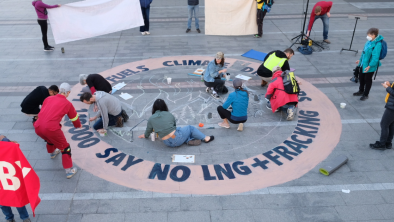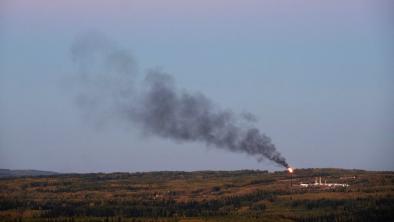Vital power route faces epic hurdles
Vancouver Sun
In a province of violent geography that demands great ingenuity of its engineers, we are in a helicopter, scrutinizing one of their greatest feats.
We pick it up near Westwood Plateau Golf and Country Club in Coquitlam, follow it 246 kilometres northeast, and end up at another grass-covered plateau — one where cattle, not golfers, are scattered.
“It” is a 500-kilovolt transmission line that carries electricity on the final segment of its journey from distant generating stations in northern and eastern B.C. to the southwestern corner of the province where 70 per cent of electricity is consumed.
British Columbia Transmission Corp. calls it the Interior-to-Lower Mainland line, or ILM, “the most critical transmission path in B.C.”
It is also emerging as the most controversial, and challenging, pathway in the province.
Documents on file with the B.C. Utilities Commission indicated that failure to get an additional line on this route by the winter of 2014 could lead to something that electrical engineers call “load shedding” — or what newspaper headline writers call “blackouts.”
The documents also indicate that BCTC does not want to commit to a firm cost estimate for the project — the working figure is $600 million — and is instead asking that the final cost be scrutinized in a formal review once the project is complete.
Part of the uncertainty arises from issues that go beyond the actual installation of transmission towers and electrical cable.
There are spotted-owl and grizzly-bear habitats to skirt, and fish-bearing streams to avoid. There are 60 first nations with territorial interests along the route, and part of accommodating them involves the largest archeological-impact assessment ever undertaken in this province.
BC Transmission Corp. vice-president of major projects Bruce Barrett describes First Nations and aboriginal issues as the Crown corporation’s foremost consideration — taking precedence over the construction of the line, and even the cost of the project.
“As engineers, we can build something almost anywhere,” Barrett explains. “It’s a matter of compromising our technical and cost aspects to accommodate environmental and first nations considerations.
“There are other things as well, including visibility along the Trans Canada Highway. There are places along the highway where the existing lines feel as if they’re right in your face. We want to find places to cross where the lines will be less visible.”
Power first flowed to the Lower Mainland along this line in 1968.
From a kilometre in the air, it looks delicate, a few strands of wire strung across tidal marsh and plunging river valley, over snowy mountain peak and bone-dry high country ranchland.
There are concrete pads to keep the transmission towers bearing the high-voltage lines from sinking into the tidal mud flats of the Lower Pitt River, just north of the Lougheed Highway in Pitt Meadows.
Ten minutes’ flight east and we see towers clinging to the side of a mountain, with exposed beds of gravel revealing spots where November rains have beaten away the surface soil and triggered landslides — some directly above the towers, forcing the installation of concrete berms to deflect away any potential debris flow in future.
In the most spectacular circumstances, the towers perch on granite outcroppings barely large enough to sink footings into, or the lines themselves hang unsupported in downward arcs for distances up to a kilometre in length as they span the valley of the Harrison River, and the Fraser River canyon.
Only about half of the existing right-of-way route is suitable for the installation of additional towers. On the other half, a new route must be developed because squeezing more towers onto the existing path would expose them to the same risks as the original set — increasing, rather than reducing, the threat of a major blackout during a wind or ice storm.
“You don’t want to put a [new] 500-kilovolt line right next to [an existing] 500-kilovolt line in an area where there are geotechnical risks,” explained Melissa Holland, BCTC’s senior project manager — and The Vancouver Sun’s tour guide on the helicopter trip.
“If there was a landslide, and it takes two lines out, then you are going to be in trouble.”
In historic terms, the most difficult area on the entire route is on the outskirts of the Lower Mainland, at Cascade Creek ridge on the east side of Stave Lake near Mission.
“The Cascade ridge is where we have probably some of the biggest challenges for the lines in terms of weather,” said Holland.
True to form, the helicopter had to skirt the top of the 3,250-foot ridge, and the sturdy tower perched at its western edge, on the morning of the tour because they were shrouded by clouds.
“The cloud ceiling is low here, and you get icing and loading during the winter months. Even though it’s very close to the Lower Mainland, it’s one of the most challenging spots to build the towers so that they can withstand the weather systems that move through here.”
A hundred kilometers northeast, in the richly forested Anderson River drainage east of the Fraser River canyon, the issue is wildlife, not weather.
“There is a challenge here with spotted-owl habitat and grizzly-bear habitat,” Holland explained. “We’re trying to find a route alignment that will by-pass these. There’s a nice little window between the two habitat areas and we will try to thread the needle, if you will.
“It’s about a 500-metre corridor between the two habitats that we are going to try to scoot through. It’s not a lot of room when you are trying to site a transmission line.”
Gwen Barlee, policy director for the Western Canada Wilderness Committee, said the project means B.C. will lose less electricity through transmission line losses, “and there are efficiencies there that lead to conservation.”
“But on the other hand, when you look at the potential impact of that project on all the wildlife habitat along that 274-kilometre route, there are concerns,” Barlee said in an interview.
“The main concerns are because we don’t have adequate protections in this province to protect species at risk — so groups like the Wilderness Committee have to look at projects like this very, very closely to make sure there aren’t undue impacts on spotted-owl habitat, or what this project means for the north Cascade grizzly-bear population.”
It will be several months before the transmission corporation is ready to submit its final route plans to the province’s Environmental Assessment office.
Preliminary discussions on the project are already under way before the B.C. Utilities Commission, which regulates BCTC, BC Hydro, ICBC, and Terasen Gas.
Documents submitted to the commission indicate no one is disputing the need for the route.
But all are expressing alarm over BCTC’s request to avoid binding itself to any hard cost estimates, but to instead submit to what it calls a “prudency review” after the project is done and the money is spent.
If BCTC fails to keep a lid on project costs, the overrun would not be recovered through higher electricity rates — it would fall to taxpayers as a whole to make up the shortfall.
“It is beyond debate that after-the-fact prudency review is an inadequate mechanism to hold utilities accountable for the wisdom of their capital projects,” said Jim Quail, executive director of the BC Public Interest Advocacy Centre, in a letter filed recently with the utilities commission.
“But even more to the point, the opportunity will be long gone to ensure that the course that is selected is in fact the best one for ratepayers and the people of the province as a whole.”
The Joint Industry Electricity Steering Committee, which represents all of British Columbia’s large industrial consumers of electricity, thinks the transmission corporation should be leashed with a “cost collar” for the project.
“The JIESC has strong reservations about the effectiveness of an ‘after-the-fact prudence review’, and accordingly is supporting a cost collar mechanism with incentives and penalties to encourage cost-effective performance by BCTC,” the committee says in a letter to the utilities commission.
The Independent Power Producers association of BC says in a submission to the BCUC that post-project reviews “do not create an environment of cost discipline.” The association notes that private electricity project developers “are subject to the same cost pressures and uncertainty”, but are expected to shoulder all the economic “risks” when they contract to sell their power to BC Hydro.
Not everyone shares that apprehension, or believes it’s appropriate to focus on costs to the exclusion of other considerations.
Gordon Mohs, heritage resource advisor for the Chehalis First Nation, ranks the transmission corporation’s involvement with the Fraser Valley aboriginal group as “fabulous.”
“I think they’ve been extremely good about everything,” Mohs said in an interview. “The consultation has been excellent. They want to do what they can in terms of accommodation on the project.”
The corporation is paying for consultants to work on behalf of first nations along the route, including a 30-kilometre strip through traditional Chehalis territory.
“It’s a very good opportunity to do some very good science and investigations into prehistory as part of the project to bring power and security of power to the Lower Mainland.
“There has been one fabulous little discovery made just north of the Chehalis Indian Reserve,” Mohs said. “It’s the Oregon spotted frog, and it’s only one of three places in all of British Columbia where these little critters are found.
“They’ve made alterations to their power line alignment to make sure there are no severe environmental impacts to the frogs.”
Mohs said the corporation is showing similar sensitivity toward cultural and archeological sites.
“The idea is that you don’t want to impact them — avoid them if you possibly can. Move the tower 50 feet to the left or the right, or north or south just to avoid that impact, because it gets very expensive when you have to excavate.”
Meanwhile, BCTC’s Barrett suggests that the route is starting to get tight because of all the competing interests along it.
The next step will probably be to rewire the existing transmission towers with lines capable of carrying much higher voltages.
“I don’t know if we’d ever put another line in this corridor.”
Instead, he says, “We will look at new adjustments that allow us to get more power out of existing corridors.”
© (c) CanWest MediaWorks Publications Inc.


